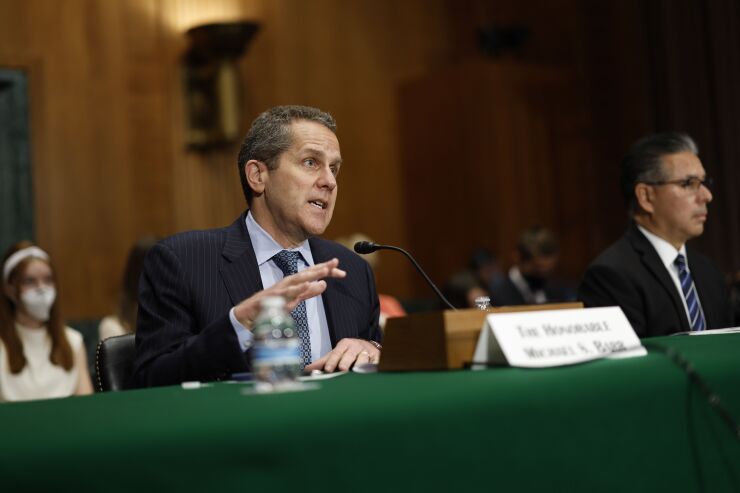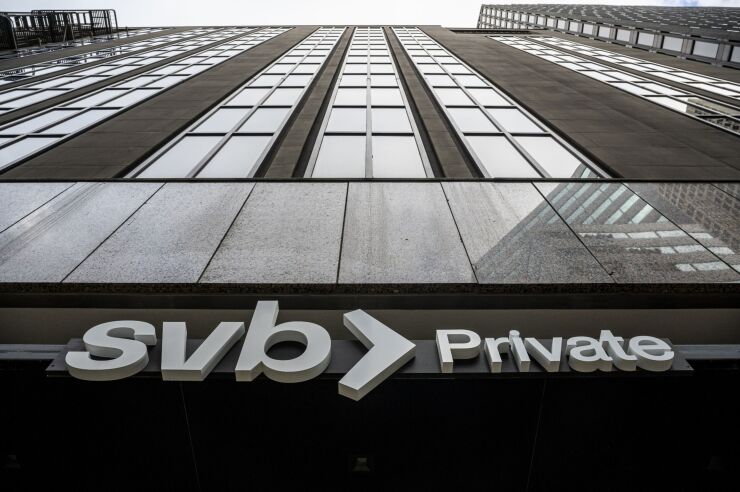
When Michael Barr delivers his
The Fed's vice chair for supervision is set to share findings from his
But for Barr's assessments — and any fresh policy proposals that come with them — to be taken seriously, experts say they must be accompanied by a detailed description of how and why the Fed, as Silicon Valley Bank's primary federal regulator, was
"There has to be some degree of blame taken for the episode or else the entire report will be dismissed and its lessons will be left on the cutting room floor," Isaac Boltansky, director of policy research at the financial services firm BTIG, said. "We've pieced together a lot of what happened over those few days, but one of the things I'm going to be looking for is, how much responsibility does the Fed take for its very clear failures alongside other external factors that are part of the conversation."
In the immediate aftermath of Silicon Valley Bank's failure, Barr and other Fed officials gave a
Barr and Fed Chair Jerome Powell have also said that on-the-ground supervisors noted the issues at Silicon Valley Bank and raised them with the bank's management in the months preceding the bank's failure.

Because so much of this information is already in the public record, Barr's report must go beyond a simple blow-by-blow account of this individual bank failure, said Karen Petrou, managing partner of Federal Financial Analytics. Instead, she would like to see evidence that the Fed has had some type of "structural epiphany" about its approach to supervision.
"I'm going to be looking to ensure that individuals senior enough to be accountable for this problem are perhaps not named, but made clear, and that significant remediation is described that goes beyond this specific case," Petrou said. "The key issue to me is: Is there any indication that the Fed has institutionally truly understood that it has to change? Because this is not the first time it's happened."
Petrou, who has served as an expert witness for litigation tied to past bank failures, said bank regulators are almost always aware of weaknesses within banks well before they reach their critical moment. Time and again, she said, supervisors have failed to translate those findings into effective remediation.
Petrou said she hopes Barr's report will focus on this disconnect in a way that emphasizes the cultural shortcomings of the agency, rather than pinning blame on individual supervisors.
"Supervisors are very low-level staffers in an organization in which people get ahead by being monetary policy or regulatory experts, and that's especially true in Washington," she said. "Supervision has always been the weak sister in the Fed's institutional culture, so it's unfair to expect a junior staffer to be a whistleblower unless they're operating in a culture in which they're going to be heard and rewarded for speaking up."
In a webinar hosted by the Peterson Institute for International Economics on Wednesday morning, former Fed Governors Daniel Tarullo and Sarah Bloom-Raskin raised similar concerns about potential findings that hang blame on individual supervisors.
"For supervisors to be effective, their political principals need to have their back," said Tarullo, who led supervision at the Fed in the years following the passage of the Dodd-Frank Act. "No matter how good and insightful a supervisor is, if she feels that she's not going to be backed up by the people in Washington, Albany, Sacramento, she's gonna pull her punches, regardless of what she sees. And I suspect that that's part of what has been going on with banks generally."
Bloom-Raskin, who was nominated by the Biden administration to be the Fed's vice chair for supervision last year but
"Supervisors live a whole ecosystem of escalation and we have to identify whether and why their calls to improve here were not heeded," she said. "That will be important."
Still, others in and around the banking sector will be looking for more information about the specific individuals tasked with monitoring Silicon Valley Bank.

In a list of outstanding questions released on Saturday, the Bank Policy Institute, an industry lobbying group, said it would like to know the average level of supervisory experience for the examiners assigned to Silicon Valley Bank and what kind of work history they had, both in bank supervision and the private sector.
BPI also raised the question about how and when Silicon Valley Bank was transitioned into a more stringent supervisory regime within the Fed. By rule, the bank should have transitioned into the Fed's Large Bank Organization portfolio once it surpassed $100 billion of assets. The organization would like to know how that change was handled and the specific timetable attached to it.
Typically, when a bank grows gradually, supervisors can prepare it for the next phase of regulatory oversight, giving them time to hire consultants and step up their management practices, Tarullo said. But given the rapid growth of Silicon Valley Bank, that likely did not happen, he said.
"When you've got a bank blowing through the levels of different supervisory portfolios very quickly, there's no preparatory time," he said. "There's no timetable to get used to things."
Tarullo also said one of the most important things for the Barr report to establish is the degree to which the issues at Silicon Valley Bank were unique to its business and circumstances or emblematic of broader issues in the banking system. Such findings would go a long way toward determining whether the Fed's policy response should be regulatory in nature or supervisory.
"If we had more confidence that we could rely on supervision, then perhaps we'd be doing some tweaking on things like changing that [accumulated other comprehensive income] opt-out, to make sure that recognized losses are reflected in capital positions," he said. "But, if we don't think we can trust supervision, or if we think that there have been real structural changes in the behavior of depositors, the frequency with which they can flee and the like, then we have to think about more fundamental changes."
David Zaring, a professor of legal studies at the University of Pennsylvania's Wharton School of Business, said there are some technical components of the Silicon Valley Bank failure that he would like to see explored in the Barr report. One aspect is the availability of the Fed's emergency lending facility, the discount window, and whether its availability should be extended in times of crisis beyond regular business hours.
Zaring would also like an explanation as to why it took regulators so long to find a suitable buyer for Silicon Valley Bank. The institution was shut down on March 10 and a sale was not announced until March 26. Once the bank failed, selling its assets became the responsibility of the Federal Deposit Insurance Corp., but Zaring said he'd like to know if the Fed could have done anything differently along the way to mitigate the losses ultimately incurred by the Deposit Insurance Fund.
"The FDIC lost serious money on this — $18 billion is a lot," he said. "I would have sold it to Wells Fargo over the weekend, if possible. There's a question as to whether the Fed made some sort of mistake that meant that couldn't be done."
Then there are the matters of apparent impropriety related to Silicon Valley Bank's leadership. Aaron Klein, a senior fellow at the Brookings Institution and former Treasury official, said he hopes the Fed will explain why executives at the bank were able to capitalize on stock options earlier this year despite the numerous concerns reportedly flagged by bank supervisors.
He added that Barr should address the conflicts of interest, both "real and perceived," in having Silicon Valley Bank CEO Greg Becker on the board of directors for the Federal Reserve Bank of San Francisco, which had supervisory authority over the bank.
Klein added that he hopes Barr focuses on the Fed's own actions and inactions related to Silicon Valley Bank and avoids getting into external factors that he feels played a small role in the bank's downfall — namely social media.
"I hope the Fed will avoid deflecting culpability and blaming Twitter for the failure of a bank whose depositors were multi million/billion dollar tech firms hardly listening to random tweets," Klein said.




